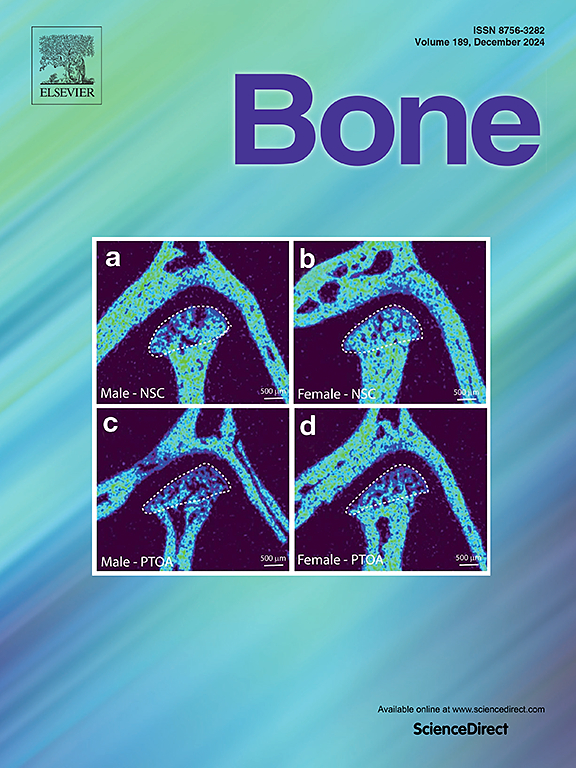Impact of denosumab on muscle health in older adults in long-term care
IF 3.5
2区 医学
Q2 ENDOCRINOLOGY & METABOLISM
引用次数: 0
Abstract
Background
Osteosarcopenia, a condition characterized by the simultaneous presence of osteoporosis and sarcopenia, is a common geriatric syndrome associated with increased risk of falls and fracture. While there are multiple medications available for the management of osteoporosis, there are currently no approved pharmacological treatments for sarcopenia.
Methods
In this secondary analysis of a 2-year, double-blind, placebo-controlled, randomized trial involving 201 men and women with osteoporosis aged ≥65 years who were residents of long-term care communities (LTCCs), we examined the impact of denosumab on various indices of muscle health. Study participants received either denosumab 60 mg every 6 months or a matching placebo. We measured appendicular lean mass (ALM/Height2), lower extremity lean mass (LELM), grip strength, chair stand test performance, gait speed, Short Physical Performance Battery (SPPB), and total hip and spine bone density at baseline and at 6, 12, and 24 months.
Results
Our study involved 78 men and 123 women, with a mean age of 81.5 years. There were no statistically significant differences between the denosumab and placebo groups in terms of changes in appendicular lean mass adjusted for ALM/Height2, LELM, chair stand performance, SPPB scores, or gait speed (all p > 0.05). However, in women, the chair stand test and grip strength showed non-significant greater improvements with denosumab at 18 and 24 months, suggesting a potential positive effect.
Conclusions
We did not find confirmatory evidence that denosumab impacts muscle health in older adults residing in LTCCs, despite its clear advantages for improving bone density. We observed non-significant improvements in grip strength and chair stand test performance in women, which warrant further investigation.
Mini abstract
Our study found that in older adults in LTCCs, denosumab did not significantly enhance muscle health indices.
denosumab对长期护理老年人肌肉健康的影响
背景:骨质疏松症是一种以骨质疏松和肌肉减少症同时存在为特征的疾病,是一种常见的老年综合征,与跌倒和骨折的风险增加有关。虽然有多种药物可用于治疗骨质疏松症,但目前尚无批准的肌肉减少症药物治疗方法。方法:在一项为期2年的、双盲、安慰剂对照、随机试验中,我们对201名年龄≥65岁的骨质疏松症患者进行了二次分析,这些患者都是长期护理社区(ltcc)的居民,我们检查了denosumab对肌肉健康各指标的影响。研究参与者每6个月服用60mg地诺单抗或相应的安慰剂。我们在基线和6、12和24个月时测量了阑尾瘦质量(ALM/Height2)、下肢瘦质量(LELM)、握力、椅架测试性能、步态速度、短物理性能电池(SPPB)以及髋和脊柱总骨密度。结果我们的研究涉及78名男性和123名女性,平均年龄81.5岁。denosumab组和安慰剂组在经ALM/ highight2、LELM、椅子站立表现、SPPB评分或步态速度调整后的阑尾瘦质量变化方面无统计学差异(p >;0.05)。然而,在女性中,在18个月和24个月时,denosumab的椅子站立测试和握力没有明显的改善,这表明它有潜在的积极作用。结论:尽管denosumab在改善骨密度方面有明显的优势,但我们没有发现确凿的证据表明denosumab会影响ltcc老年人的肌肉健康。我们观察到女性在握力和椅子站立测试中的表现没有显著的改善,这需要进一步的研究。一项研究发现,在ltcc的老年人中,denosumab并没有显著增强肌肉健康指标。
本文章由计算机程序翻译,如有差异,请以英文原文为准。
求助全文
约1分钟内获得全文
求助全文
来源期刊

Bone
医学-内分泌学与代谢
CiteScore
8.90
自引率
4.90%
发文量
264
审稿时长
30 days
期刊介绍:
BONE is an interdisciplinary forum for the rapid publication of original articles and reviews on basic, translational, and clinical aspects of bone and mineral metabolism. The Journal also encourages submissions related to interactions of bone with other organ systems, including cartilage, endocrine, muscle, fat, neural, vascular, gastrointestinal, hematopoietic, and immune systems. Particular attention is placed on the application of experimental studies to clinical practice.
 求助内容:
求助内容: 应助结果提醒方式:
应助结果提醒方式:


